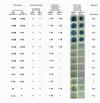Functional investigation of grass carp reovirus nonstructural protein NS80
- PMID: 21489306
- PMCID: PMC3101161
- DOI: 10.1186/1743-422X-8-168
Functional investigation of grass carp reovirus nonstructural protein NS80
Abstract
Background: Grass Carp Reovirus (GCRV), a highly virulent agent of aquatic animals, has an eleven segmented dsRNA genome encased in a multilayered capsid shell, which encodes twelve proteins including seven structural proteins (VP1-VP7), and five nonstructural proteins (NS80, NS38, NS31, NS26, and NS16). It has been suggested that the protein NS80 plays an important role in the viral replication cycle that is similar to that of its homologous protein μNS in the genus of Orthoreovirus.
Results: As a step to understanding the basis of the part played by NS80 in GCRV replication and particle assembly, we used the yeast two-hybrid (Y2H) system to identify NS80 interactions with proteins NS38, VP4, and VP6 as well as NS80 and NS38 self-interactions, while no interactions appeared in the four protein pairs NS38-VP4, NS38-VP6, VP4-VP4, and VP4-VP6. Bioinformatic analyses of NS80 with its corresponding proteins were performed with all currently available homologous protein sequences in ARVs (avian reoviruses) and MRVs (mammalian reoviruses) to predict further potential functional domains of NS80 that are related to VFLS (viral factory-like structures) formation and other roles in viral replication. Two conserved regions spanning from aa (amino acid) residues of 388 to 433, and 562 to 580 were discovered in this study. The second conserved region with corresponding conserved residues Tyr565, His569, Cys571, Asn573, and Glu576 located between the two coiled-coils regions (aa ~513-550 and aa ~615-690) in carboxyl-proximal terminus were supposed to be essential to form VFLS, so that aa residues ranging from 513 to 742 of NS80 was inferred to be the smallest region that is necessary for forming VFLS. The function of the first conserved region including Ala395, Gly419, Asp421, Pro422, Leu438, and Leu443 residues is unclear, but one-third of the amino-terminal region might be species specific, dominating interactions with other viral components.
Conclusions: Our results in this study together with those from previous investigations indicate the protein NS80 might play a central role in VFLS formation and viral components recruitment in GCRV particle assembly, similar to the μNS protein in ARVs and MRVs.
Figures




Similar articles
-
Nonstructural protein NS80 is crucial in recruiting viral components to form aquareoviral factories.PLoS One. 2013 May 6;8(5):e63737. doi: 10.1371/journal.pone.0063737. Print 2013. PLoS One. 2013. PMID: 23671697 Free PMC article.
-
The N-Terminal of Aquareovirus NS80 Is Required for Interacting with Viral Proteins and Viral Replication.PLoS One. 2016 Feb 12;11(2):e0148550. doi: 10.1371/journal.pone.0148550. eCollection 2016. PLoS One. 2016. PMID: 26871941 Free PMC article.
-
Characterization of the nonstructural protein NS80 of grass carp reovirus.Arch Virol. 2010 Nov;155(11):1755-63. doi: 10.1007/s00705-010-0753-6. Epub 2010 Jul 18. Arch Virol. 2010. PMID: 20640908
-
Grass Carp Reovirus Nonstructural Proteins Avoid Host Antiviral Immune Response by Targeting the RLR Signaling Pathway.J Immunol. 2022 Feb 1;208(3):707-719. doi: 10.4049/jimmunol.2100723. Epub 2022 Jan 12. J Immunol. 2022. PMID: 35022273
-
Nonstructural proteins involved in genome packaging and replication of rotaviruses and other members of the Reoviridae.Virus Res. 2004 Apr;101(1):57-66. doi: 10.1016/j.virusres.2003.12.006. Virus Res. 2004. PMID: 15010217 Review.
Cited by
-
Aquareovirus NS80 recruits viral proteins to its inclusions, and its C-terminal domain is the primary driving force for viral inclusion formation.PLoS One. 2013;8(2):e55334. doi: 10.1371/journal.pone.0055334. Epub 2013 Feb 12. PLoS One. 2013. PMID: 23424630 Free PMC article.
-
Aquareovirus protein VP6 colocalizes with NS80 protein in infected and transfected cells.Virol J. 2013 Apr 27;10:133. doi: 10.1186/1743-422X-10-133. Virol J. 2013. PMID: 23622425 Free PMC article.
-
Grass Carp Reovirus Induces Formation of Lipid Droplets as Sites for Its Replication and Assembly.mBio. 2022 Dec 20;13(6):e0229722. doi: 10.1128/mbio.02297-22. Epub 2022 Nov 29. mBio. 2022. PMID: 36445081 Free PMC article.
-
Sequence analysis of the genome of piscine orthoreovirus (PRV) associated with heart and skeletal muscle inflammation (HSMI) in Atlantic salmon (Salmo salar).PLoS One. 2013 Jul 29;8(7):e70075. doi: 10.1371/journal.pone.0070075. Print 2013. PLoS One. 2013. PMID: 23922911 Free PMC article.
-
Characterization of grass carp reovirus minor core protein VP4.Virol J. 2012 Jul 5;9:89. doi: 10.1186/1743-422X-9-89. Virol J. 2012. PMID: 22559058 Free PMC article.
References
-
- Mertens PPC, Attoui H, Duncan R, Dermody TS. In: Virus Taxonomy Eighth Report of the International Committee on Taxonomy of Viruses. Fauquet CM, Mayo MA, Maniloff J, Desselberger U, Ball LA, editor. San Diego, CA: Elsevier Inc; 2005. Reoviridae.
-
- Rangel AA, Rockemann DD, Hetrick FM, Samal SK. Identification of grass carp hemorrhage virus as a new genogroup of Aquareovirus. J Gen Virol. 1999;80:2399–2402. - PubMed
-
- Attoui H, Fang Q, Mohd Jaafar F, Cantaloube JF, Biagini P, De Micco P, De Lamballerie X. Common evolutionary origin of aquareoviruses and orthoreoviruses revealed by genome characterization of Golden shiner reovirus, Grass carp reovirus, Striped bass reovirus and Golden ide reovirus (genus Aquareovirus, family Reoviridae) J Gen Virol. 2002;83:1941–1951. - PubMed
Publication types
MeSH terms
Substances
LinkOut - more resources
Full Text Sources
Research Materials

